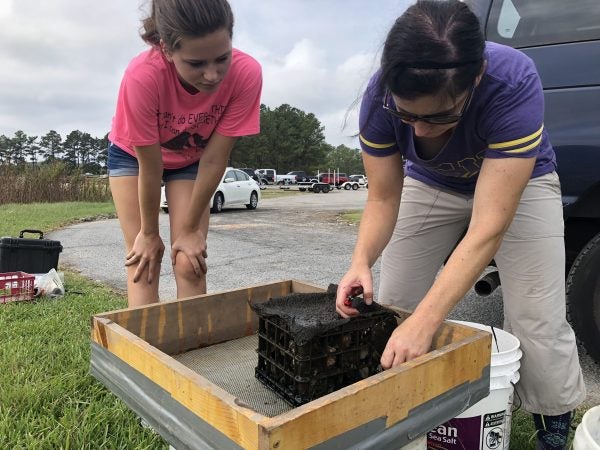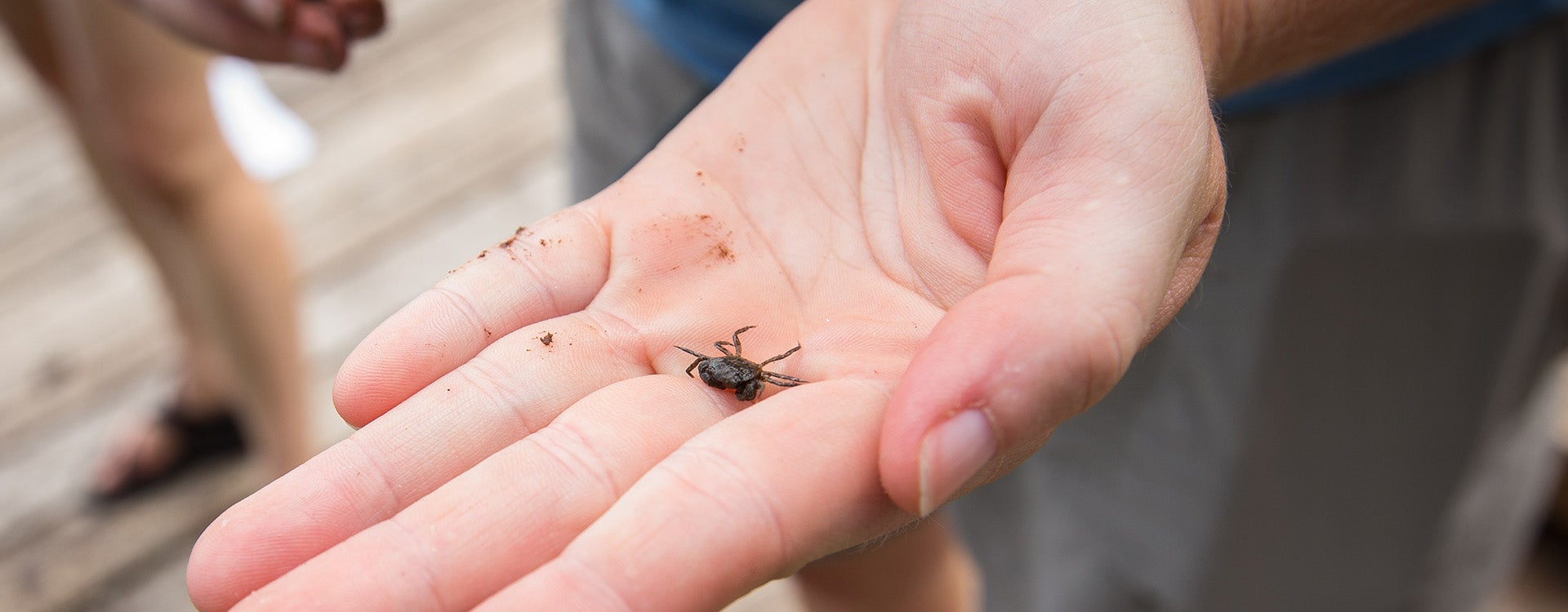ZOMBIE CRABS
Researchers track body-snatching parasite

April Blakeslee, right, and student Chloe Gabriel prepare a “crab condo,” a plastic crate containing oyster shells, which they use to monitor mud crab populations.
(Photo courtesy of Jessica Wells)
A parasitic barnacle present in eastern North Carolina’s estuaries is highly damaging to its mud crab hosts — castrating them and replacing the crab’s reproductive system with its own, fooling the crab into protecting the parasite’s spawn.
“Once infected, the crab host becomes reproductively dead,” said Dr. April Blakeslee, assistant professor of biology at East Carolina University. “The parasite accomplishes this feat by invading the crab’s body as a series of roots that extends throughout the tissues of the crab, including its nerve center.”
The parasite’s takeover of the bodies and behavior of the still-living crabs led the team to dub the infected creatures “zombie crabs.”
“This host-parasite system is truly a real-life case of ‘Invasion of the Body Snatchers,’” Blakeslee said. “In fact, invasion is a highly appropriate word here, not only because the parasite invades its host’s body, but also because the parasite (Loxothylacus panopaei) is an invasive species to Atlantic waters.
“The parasite likely first invaded the Chesapeake Bay with crabs associated with transplanted oysters from the Gulf of Mexico in the 1960s, continuing to spread along the Atlantic coast.”
Since July 2016, Blakeslee and students in her lab have monitored mud crab populations in the Pamlico and Neuse rivers, sampling sites every 6-8 weeks along a salinity gradient — saltier sites near the mouths of the rivers and less salty sites upstream.
Three years of data appear to support one of the team’s original hypotheses — that fresher water provides a refuge for the crabs from the parasite. Crabs from sites with average salinities less than 10 parts per thousand do not become infected, while sites with salinities greater than 10 parts per thousand have infection rates as high as 80%.
The research has also determined that when the rate of infection goes up, the abundance of the crabs goes down — likely because of the negative effect of the parasite on crab reproduction — and there’s a higher rate of predation by larger crab predators.

Dawson Wright, left, and Tim Lee take readings at a monitoring site.
(Photo courtesy of Jessica Wells)
“Our work on this host-parasite system is furthering efforts to uncover potential impacts that the invasive parasite has on crab populations in the region, and how that may scale up from crab populations to estuarine communities,” Blakeslee said. “We will continue to sample North Carolina estuaries to collect more data on the parasite, its hosts and community interactions, particularly in the Pamlico estuary.”
Monitoring the impact of the parasite is important because of the mud crabs’ role in the food web.
“They are prey for things like blue crabs, lots of fish and birds. And in turn they eat tiny things within the oyster beds. Studies have shown that if you pull out these intermediate species, the whole system can fall apart,” Blakeslee said.
One of the sites where the team has deployed its “crab condos” — plastic crates filled with oyster shells that provide habitat for mud crabs but don’t trap them — is the North Carolina Estuarium in Washington. In addition to letting the team use the site for its monitoring efforts, the estuarium partnered with Blakeslee and Kayla Clark of ECU’s School of Art and Design to develop an exhibit on biological invasions featuring the zombie crabs, which opened in 2017.
The zombie crab exhibit will be showcased at the N.C. Estuarium’s third annual “Estuscarium” event from 5-8 p.m. on Saturday, Oct. 26. The event is free and includes carnival games, face painting and interactive presentations. Costumes are encouraged but not required.
“It’s a fun event, and you can learn even more about North Carolina’s estuaries and how they can sometimes be home to the living dead!” Blakeslee said.

